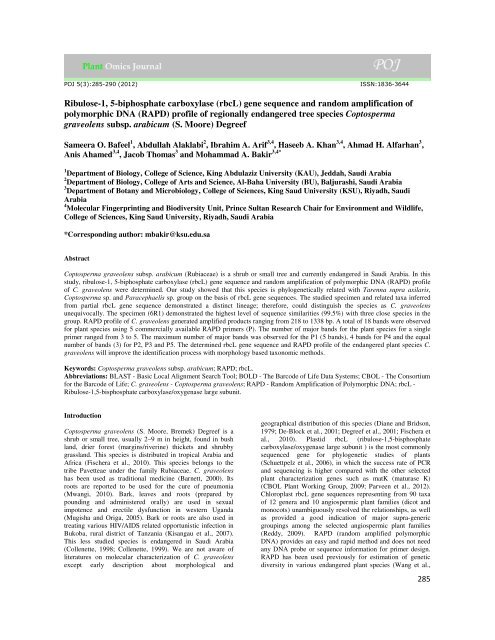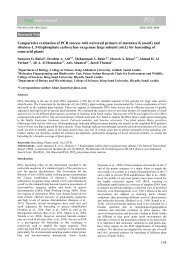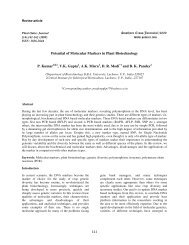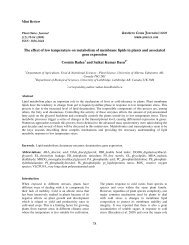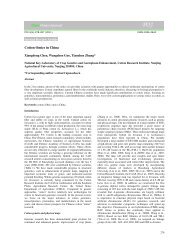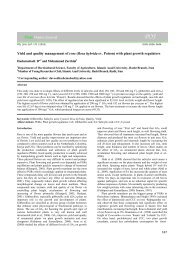Ribulose-1, 5-biphosphate carboxylase (rbcL) gene ... - Plant Omics
Ribulose-1, 5-biphosphate carboxylase (rbcL) gene ... - Plant Omics
Ribulose-1, 5-biphosphate carboxylase (rbcL) gene ... - Plant Omics
You also want an ePaper? Increase the reach of your titles
YUMPU automatically turns print PDFs into web optimized ePapers that Google loves.
POJ 5(3):285-290 (2012)<br />
ISSN:1836-3644<br />
<strong>Ribulose</strong>-1, 5-<strong>biphosphate</strong> <strong>carboxylase</strong> (<strong>rbcL</strong>) <strong>gene</strong> sequence and random amplification of<br />
polymorphic DNA (RAPD) profile of regionally endangered tree species Coptosperma<br />
graveolens subsp. arabicum (S. Moore) Degreef<br />
Sameera O. Bafeel 1 , Abdullah Alaklabi 2 , Ibrahim A. Arif 3,4 , Haseeb A. Khan 3,4 , Ahmad H. Alfarhan 3 ,<br />
Anis Ahamed 3,4 , Jacob Thomas 3 and Mohammad A. Bakir 3,4*<br />
1 Department of Biology, College of Science, King Abdulaziz University (KAU), Jeddah, Saudi Arabia<br />
2 Department of Biology, College of Arts and Science, Al-Baha University (BU), Baljurashi, Saudi Arabia<br />
3 Department of Botany and Microbiology, College of Sciences, King Saud University (KSU), Riyadh, Saudi<br />
Arabia<br />
4 Molecular Fingerprinting and Biodiversity Unit, Prince Sultan Research Chair for Environment and Wildlife,<br />
College of Sciences, King Saud University, Riyadh, Saudi Arabia<br />
*Corresponding author: mbakir@ksu.edu.sa<br />
Abstract<br />
Coptosperma graveolens subsp. arabicum (Rubiaceae) is a shrub or small tree and currently endangered in Saudi Arabia. In this<br />
study, ribulose-1, 5-<strong>biphosphate</strong> <strong>carboxylase</strong> (<strong>rbcL</strong>) <strong>gene</strong> sequence and random amplification of polymorphic DNA (RAPD) profile<br />
of C. graveolens were determined. Our study showed that this species is phylo<strong>gene</strong>tically related with Tarenna supra axilaris,<br />
Coptosperma sp. and Paracephaelis sp. group on the basis of <strong>rbcL</strong> <strong>gene</strong> sequences. The studied specimen and related taxa inferred<br />
from partial <strong>rbcL</strong> <strong>gene</strong> sequence demonstrated a distinct lineage; therefore, could distinguish the species as C. graveolens<br />
unequivocally. The specimen (6R1) demonstrated the highest level of sequence similarities (99.5%) with three close species in the<br />
group. RAPD profile of C. graveolens <strong>gene</strong>rated amplified products ranging from 218 to 1338 bp. A total of 18 bands were observed<br />
for plant species using 5 commercially available RAPD primers (P). The number of major bands for the plant species for a single<br />
primer ranged from 3 to 5. The maximum number of major bands was observed for the P1 (5 bands), 4 bands for P4 and the equal<br />
number of bands (3) for P2, P3 and P5. The determined <strong>rbcL</strong> <strong>gene</strong> sequence and RAPD profile of the endangered plant species C.<br />
graveolens will improve the identification process with morphology based taxonomic methods.<br />
Keywords: Coptosperma graveolens subsp. arabicum; RAPD; <strong>rbcL</strong>.<br />
Abbreviations: BLAST - Basic Local Alignment Search Tool; BOLD - The Barcode of Life Data Systems; CBOL - The Consortium<br />
for the Barcode of Life; C. graveolens - Coptosperma graveolens; RAPD - Random Amplification of Polymorphic DNA; <strong>rbcL</strong> -<br />
<strong>Ribulose</strong>-1,5-bisphosphate <strong>carboxylase</strong>/oxygenase large subunit.<br />
Introduction<br />
Coptosperma graveolens (S. Moore, Bremek) Degreef is a<br />
shrub or small tree, usually 2–9 m in height, found in bush<br />
land, drier forest (margins/riverine) thickets and shrubby<br />
grassland. This species is distributed in tropical Arabia and<br />
Africa (Fischera et al., 2010). This species belongs to the<br />
tribe Pavetteae under the family Rubiaceae. C. graveolens<br />
has been used as traditional medicine (Barnett, 2000). Its<br />
roots are reported to be used for the cure of pneumonia<br />
(Mwangi, 2010). Bark, leaves and roots (prepared by<br />
pounding and administered orally) are used in sexual<br />
impotence and erectile dysfunction in western Uganda<br />
(Mugisha and Origa, 2005). Bark or roots are also used in<br />
treating various HIV/AIDS related opportunistic infection in<br />
Bukoba, rural district of Tanzania (Kisangau et al., 2007).<br />
This less studied species is endangered in Saudi Arabia<br />
(Collenette, 1998; Collenette, 1999). We are not aware of<br />
literatures on molecular characterization of C. graveolens<br />
except early description about morphological and<br />
geographical distribution of this species (Diane and Bridson,<br />
1979; De-Block et al., 2001; Degreef et al., 2001; Fischera et<br />
al., 2010). Plastid <strong>rbcL</strong> (ribulose-1,5-bisphosphate<br />
<strong>carboxylase</strong>/oxygenase large subunit ) is the most commonly<br />
sequenced <strong>gene</strong> for phylo<strong>gene</strong>tic studies of plants<br />
(Schuettpelz et al., 2006), in which the success rate of PCR<br />
and sequencing is higher compared with the other selected<br />
plant characterization <strong>gene</strong>s such as matK (maturase K)<br />
(CBOL <strong>Plant</strong> Working Group, 2009; Parveen et al., 2012).<br />
Chloroplast <strong>rbcL</strong> <strong>gene</strong> sequences representing from 90 taxa<br />
of 12 <strong>gene</strong>ra and 10 angiospermic plant families (dicot and<br />
monocots) unambiguously resolved the relationships, as well<br />
as provided a good indication of major supra-<strong>gene</strong>ric<br />
groupings among the selected angiospermic plant families<br />
(Reddy, 2009). RAPD (random amplified polymorphic<br />
DNA) provides an easy and rapid method and does not need<br />
any DNA probe or sequence information for primer design.<br />
RAPD has been used previously for estimation of <strong>gene</strong>tic<br />
diversity in various endangered plant species (Wang et al.,<br />
285
2005; Zheng et al., 2008). Thus, widely used <strong>rbcL</strong> <strong>gene</strong><br />
sequence and RAPD markers may help the conservation and<br />
sustainable maintenance of this plant species. In this study,<br />
we attempted to characterize this regionally endangered plant<br />
species by <strong>rbcL</strong> <strong>gene</strong> sequence and RAPD fingerprinting.<br />
Results and Discussion<br />
Taxonomy<br />
Morphological description and geographic distribution of the<br />
genus Coptosperma is well documented by Degreef et al.<br />
(2001). Genus Coptosperma currently has 11 species and 2<br />
subspecies of C. graveolens (i.e. C. graveolens subsp.<br />
graveolens var. graveolens; C. graveolens subsp. graveolens<br />
var. impolitum; C. graveolens subsp. arabicum), of which C.<br />
graveolens subsp. arabicum is the only species, found in the<br />
Arabian Peninsula (Collenette, 1999; Chaudhary, 2000).<br />
Coptosperma graveolens (S. Moore) Degreef [Synonym,<br />
Pavetta graveolens S. Moore; Tarenna graveolens (S.<br />
Moore) Bremek] has all the <strong>gene</strong>ric characters of<br />
Coptosperma but lacks the ruminate endosperm (Bridson,<br />
1979; Degreef et al., 2001). The C. graveolens<br />
morphologically resembles C. neurophyllum but differs from<br />
the latter by the presence of pubescent leaves (abaxial<br />
surface), subulate bracteoles and circular hilum cavity.<br />
Almost all of the Coptosperma species are characterized by<br />
terminal inflorescence. The unique species with axillary<br />
inflorescene is C. supra-axilaris. The Tarenna graveolens<br />
was transferred from Tarenna sensu stricto to the genus<br />
Coptosperma based on spherical seed, no thickenings of the<br />
exotesta cells and pollen with microreticulate exine.<br />
The C. graveolens subsp. arabicum is characterized by<br />
puberulous leaves; calyx tube as long as the triangular lobes,<br />
ovate to triangular or rarely acuminate stipules, terminal<br />
inflorescence; subulate, pubescent bracteoles; ovules 2-3 (-7),<br />
2-3 or 2-4; placentation impressed; hilar cavity is circular,<br />
pale and entire endosperm. The C. graveolens subsp.<br />
arabicum is particularly characterized with puberulous<br />
leaves, 2-4 ovules and circular hilar cavity (Degreef et al.,<br />
2001). Bridson (1979) described the Arabian material as<br />
subsp. arabica (Cufod.) Bridson with leaf-blades always<br />
narrowly elliptic, the inflorescences smaller than those of<br />
subsp. graveolens and calyx-lobes acute to more or less<br />
rounded (Fig. 1).<br />
Phylogeny (Maximum Likelihood, Maximum Parsimony<br />
and Neighbor-Joining)<br />
BLAST (Basic Local Alignment Search Tool) search, <strong>gene</strong>tic<br />
distance and tree-based methods have been commonly used<br />
for identification of species. In this process, sequence is<br />
assigned on the basis of its similarity to a set of reference<br />
(identified) sequences (Ross et al., 2008). We conducted<br />
BLAST and BOLD (The Barcode of Life Data Systems)<br />
database-search to determine the approximate identification<br />
and related taxa of the studied specimen. BLAST search<br />
showed 99% sequence similarities with multiple plant species<br />
(Randia dryadum, FJ976170; Tarenna supra-axilaris,<br />
AJ286711; Coptosperma sp., AM117218). BOLD database<br />
showed 99.5% sequence similarities with Tarenna supraaxilaris.<br />
We retrieved the related sequences from the<br />
GgenBank database to determine the phylo<strong>gene</strong>tic position of<br />
the studied specimen. Tree analyses were conducted using<br />
maximum likelihood, maximum parsimony and neighbor<br />
joining methods. The studied specimen was phylo<strong>gene</strong>tically<br />
related with Tarenna supra axilaris-Coptosperma sp.-<br />
Paracephaelis sp. group (Fig. 2; supplementary Figs. 1 and<br />
2). All the trees that were inferred from partial <strong>rbcL</strong> <strong>gene</strong><br />
sequence of the studied specimen and related taxa<br />
demonstrated a distinct lineage of the studied specimen; thus,<br />
could distinguish the species of C. graveolens unequivocally.<br />
Absence of C. graveolens sequence and related <strong>gene</strong>ra in the<br />
database may be responsible for such tree-topology. There<br />
are very few <strong>rbcL</strong> records of plants on the current<br />
GenBank/BOLD identification system (v 2.5) (Ratnasingham<br />
and Hebert, 2007), so queries may not return an authentic<br />
match. Recent study showed that 13-fold expansion of taxon<br />
sampling resulted in improved phylo<strong>gene</strong>tic assessment,<br />
despite of up to 38% missing data (Crawley and Hilu, 2012).<br />
The specimen demonstrated the highest level of sequence<br />
similarities (99.5%) with these plant species compared with<br />
other taxa. Overall mean sequence similarity among the<br />
studied plant species was very high (99.3%) (Table 1).<br />
Assignment of an unknown specimen under valid taxa<br />
primarily depends on the availability of the sequence in the<br />
database. Molecular <strong>gene</strong>tic techniques for species<br />
identification based on single-<strong>gene</strong> sequence similarity or<br />
phylogenies are rapidly gaining wide use (Ross et al., 2008)<br />
except few criticisms (Will and Rubinoff, 2004; Meyer and<br />
Paulay, 2005). One of the prime motivations for the<br />
development of <strong>gene</strong>tic methods is their large-scale<br />
application to species identification. BLAST, distance and<br />
liberal tree-based methods showed equally success when all<br />
species are represented in the reference data set (Ross et al.,<br />
2008).<br />
RAPD<br />
Sequence-based analyses sometimes fail to distinguish<br />
between species because of the significant similarity between<br />
their DNA sequences in the amplified region. In such<br />
instances, RAPD primers are able to distinguish taxa (Choo<br />
et al., 2009), because RAPD analysis includes both of the<br />
coding and non-coding regions of the genome (Vanijajiva et<br />
al., 2005). RAPD has been used in botanic forensic purposes<br />
(Mestel, 1993; Yoon, 1993). The RAPD-primers (P1, P2, P3,<br />
P4 and P5) used in this study were able to amplify the DNA<br />
obtained from the plant-specimen. The RAPD banding<br />
patterns of C. graveolens is illustrated in Fig. 3. The RAPD<br />
profile using the sample <strong>gene</strong>rated amplified products ranged<br />
from 218 to 1338 bp. A total of 18 bands were observed for<br />
the plant species using 5 primers. The number of major bands<br />
for the plant species for a single primer ranged from 3 to 5.<br />
The maximum number of major bands was observed for the<br />
primer P1 (5 bands), 4 bands for P4 and the equal number of<br />
bands for P2, P3 and P5 (3 bands, Fig. 3). Some of the<br />
reported problems with RAPD are related to reproducibility,<br />
designing appropriate primers and amplification of RAPD-<br />
PCR products. PCR conditions constitute another crucial<br />
factor for obtaining amplified products, especially for plants<br />
(Jones et al., 1997). However, if the overall temperature<br />
profiles (annealing temperature) inside the PCR tubes are<br />
identical, RAPD fragments are then likely to be reproducible<br />
(Penner et al., 1993; Skroch and Nienhuis, 1995).<br />
286
Table 1. Estimates of <strong>rbcL</strong> <strong>gene</strong> sequence similarities (%) among the studied taxa. The highest sequence similarities with<br />
C. graveolens subsp. arabicum were typed in bold. Overall mean sequence similarity is 99.3%.<br />
No. Species 1 2 3 4 5 6 7 8 9 10 11 12 13<br />
1 Tarenna neurophylla<br />
2 Tarenna buruensis 99.9<br />
3 Tarenna supra axillaris 99.6 99.7<br />
4 Coptosperma sp. 99.6 99.6 99.6<br />
5 Paracephaelis sp. 99.4 99.4 99.4 99.6<br />
6 Dictyandra arborescens 98.7 99.2 98.2 99.1 99.1<br />
7 Leptactina platyphylla 98.6 99.0 98.2 98.8 98.9 99.8<br />
8 Amaioua guianensis 99.1 98.9 98.9 98.9 98.7 99.0 98.8<br />
9 Sukunia longipes 98.6 99.1 98.6 99.0 99.0 98.3 98.3 98.6<br />
10 Randia schumanniana 99.2 99.1 99.1 99.1 99.1 98.8 98.6 98.8 99.2<br />
11 Gardenia jasminoides 99.0 98.8 99.1 99.1 99.0 98.7 98.7 98.8 99.3 99.3<br />
12 Randia dryadum 99.0 99.0 98.8 99.0 99.0 98.5 98.3 98.8 98.8 99.9 99.3<br />
13 Coptosperma graveolens 99.3 99.3 99.5 99.5 99.5 99.1 99.1 98.7 98.9 98.9 98.4 98.8<br />
14 Aidia sp. 98.9 98.8 98.9 98.7 98.7 98.9 98.8 98.7 99.1 98.9 99.0 98.9 98.4<br />
Fig 1. a. Regionally endangered plant C. graveolens subsp. arabicum in the sample collected site (Al-Baha, Saudi Arabia); b.<br />
Flower; c. Leaf and fruits.<br />
Materials and methods<br />
<strong>Plant</strong> material<br />
In this study, one specimen (6R1, Fig. 1) collected from Al-<br />
Baha, Saudi Arabia (19.8597001707, 41.3083145406) was<br />
investigated. The leaf samples were individually placed in<br />
plastic pouches and transported to the laboratory where the<br />
specimen was stored at -80 o C until processed for DNA<br />
extraction. The plant was morphologically identified at<br />
Herbarium, King Saud University (KSU), Riyadh, Saudi<br />
Arabia.<br />
DNA extraction<br />
The leaf specimen was immersed in liquid nitrogen and<br />
crushed using sterile mortar and pestle to get a fine powder.<br />
DNeasy plant mini kit (Qiagen) and an automated DNA<br />
extraction instrument (QIAcube, Qiagen) were used for DNA<br />
isolation. Quality of the extracted DNA was determined<br />
using gel electrophoresis and Nanodrop 8000<br />
Spectrophotometer (Thermo Scientific, Wilmington, USA).<br />
Isolated plant genomic DNA was preserved at -80 o C.<br />
PCR<br />
A set of primer, <strong>rbcL</strong>aF (5′ATGTCACCACAAACAG-<br />
AGACTAAAGC3′; Levin et al., 2003) and <strong>rbcL</strong>aR<br />
(5′GTAAAATCAAGTCCACCRCG3′; Kress and Erickson,<br />
2007) was used in this study for the amplification of <strong>rbcL</strong><br />
<strong>gene</strong> of the chloroplast. A total volume of 30 µl of PCR<br />
reaction mixture prepared as follows: 15 µl of FideliTaq PCR<br />
Master Mix (USB Corporation, Cleveland, OH), a final<br />
concentration of 200 µM of each dNTPs and 1.5 mM MgCl 2 ,<br />
1µM of each primer (Eurofins MWG Operon, Germany), 2<br />
µL of genomic DNA, adjusted with sterile distilled water (to<br />
30 µl). The PCR amplification was performed with a Veriti<br />
96 well plate thermal cycler (Applied Biosystems) as follows:<br />
95°C for 1 min, followed by 35 cycles of 95°C for 30s, 51°C<br />
for 30s and 68°C for 1 min, followed by an final elongation<br />
step at 68°C for 5 min.<br />
287
Fig 2. The Maximum Likelihood tree showing the relationship of C. graveolens subsp. arabicum with the related taxa. GenBank<br />
accession numbers of the corresponding taxa are written in parentheses. The percentage of replicate trees, in which the associated<br />
taxa clustered together in the bootstrap test (1000 replicates) are shown (>50%) next to the branches. The scale bar represents the<br />
branch length measurement in the number of substitutions per site.<br />
Fig 3. RAPD-PCR products of C. graveolens subsp. arabicum for different primers. M, 100-bp molecular weight marker; P, Ready-<br />
To-Go RAPD analysis primers (GE Healthcare, Buckinghamshire, UK); MW, Molecular Weight.<br />
Agarose gel electrophoresis<br />
A long (20 × 14 cm) 1% agarose gel using 1X TAE buffer<br />
containing 0.5 µg/mL ethidium bromide was used for<br />
electrophoresis of PCR-products. Gel images were obtained<br />
using Proxima C16 Phi+ (Isogen Life Science) UV<br />
transilluminator and Opticom (version 3.2.5; OptiGo)<br />
imaging system. The amplified PCR products were<br />
determined on gel for the presence or absence of the band.<br />
The size of PCR products resulting from the primer pair were<br />
determined by using an Amersham 100-bp ladder (GE<br />
Healthcare) and the TotalLab TL100 1D software (version<br />
2008.01).<br />
Sequencing<br />
Sequences were determined directly using the<br />
dideoxynucleotide chain-termination method with a DNA-<br />
Sequencer (ABI PRISM 3130xl; Applied Biosystems/<br />
Hitachi) and BigDye Terminator (version 3.1) cycle<br />
sequencing kit (RR-100, Applied Biosystems), according to<br />
the manufacturer's instructions. Obtained <strong>rbcL</strong> <strong>gene</strong> sequence<br />
was submitted to DDBJ/EMBL/GenBank database<br />
(Accession no. JQ665721).<br />
Assignment of taxa<br />
BLAST and BOLD searches were applied to the produced<br />
sequence using the available online databases. Sequences of<br />
<strong>rbcL</strong> that matched closely with the query sequences were<br />
retrieved from DDBJ/EMBL/GenBank database. The<br />
sequences were aligned using CLUSTAL X (version 1.81)<br />
(Thompson et al., 1997). Phylo<strong>gene</strong>tic analyses were<br />
conducted in MEGA4 (Tamura et al., 2007). Phylo<strong>gene</strong>tic<br />
trees were constructed using Maximum Likelihood (ML;<br />
Tamura and Nei, 1993), Maximum Parsimony (MP; Nei and<br />
Kumar, 2000) and Neighbor-Joining (NJ; Saitou and Nei,<br />
1987) methods. The topologies of the phylo<strong>gene</strong>tic trees were<br />
evaluated using the bootstrap re-sampling method of<br />
Felsenstein (1985) with 1000 replicates.<br />
RAPD-PCR analysis<br />
Ready-To-Go RAPD analysis beads (GE Healthcare,<br />
Buckinghamshire, UK) were used for RAPD-PCR analysis.<br />
The PCR mixture of 25 µL contained a single Ready-To-Go<br />
RAPD analysis bead, 25 pmol of a single RAPD primer, 50<br />
ng of template DNA and sterile distilled water. The bead<br />
contained thermo-stable polymerase (AmpliTaq DNA<br />
polymerase and Stoffel fragment), dNTPs (0.4 mM each),<br />
288
BSA (2.5 µg) and buffer (3 mM MgCl<br />
2<br />
, 30 mM KCl and 10<br />
mM Tris, pH 8.3). Five primers (GE Healthcare, UK) were<br />
used in this study. Each primer is a 10-mer of arbitrary<br />
sequence: RAPD Analysis Primer 1 (P1) (5'-<br />
d[GGTGCGGGAA]-3'); RAPD Analysis Primer 2 (P2) (5'-<br />
d[GTTTCGCTCC]-3'); RAPD Analysis Primer 3 (P3) (5'-<br />
d[AAGAGCCCGT]-3'); RAPD Analysis Primer 4 (P4) (5'-<br />
d[AACGCGCAAC]-3') and RAPD Analysis Primer 5 (P5)<br />
(5'-d[CCCGTCAGCA]-3'). PCR was performed using a<br />
Veriti 96-well thermal cycler (Applied Biosystems, USA).<br />
PCR conditions included 1 cycle of 95°C for 5 min, followed<br />
by 45 cycles of 95°C for 1 min, 36°C for 1 min and 72°C for<br />
2 min. A long (20 × 14 cm) 1% agarose gel using 1X TAE<br />
buffer containing 0.5 µg/mL ethidium bromide was used for<br />
electrophoresis of the products. Gel images were obtained<br />
using Proxima C16 Phi+ (Isogen Life Science) UV<br />
transilluminator and Opticom (version 3.2.5; OptiGo)<br />
imaging system. Gel image analysis of the RAPD bands obtained<br />
for the plant species using different RAPD primers<br />
was performed using an Amersham 100-bp ladder (GE<br />
Healthcare) and the TotalLab TL100 1D software (version<br />
2008.01).<br />
Conclusion<br />
We primarily identified the endangered plant species on the<br />
basis of morphology. The combination of <strong>rbcL</strong> <strong>gene</strong><br />
sequence and RAPD profile of C. graveolens subsp.<br />
arabicum may amend the identification process and help the<br />
conservation and tackling illegal trade of this regionally<br />
endangered species. As morphology based taxonomic<br />
methods require the whole plant, preferably in flowering<br />
stage for its authentic identification, DNA sequence may<br />
offer identification of the species even if a trace of tissue is<br />
available. Phylo<strong>gene</strong>tic position or relationship of this<br />
species with other taxa must be drawn with caution as only<br />
few sequences of the related taxa are currently available in<br />
the databases. However, the presence of <strong>rbcL</strong> and other plant<br />
<strong>gene</strong> sequences in the databases has been increasingly fast.<br />
Therefore, future work on this species will provide reliable<br />
information regarding the phylogeny of this species.<br />
Acknowledgements<br />
Supports from the Deanship of Scientific Research, College<br />
of Science Research Center, King Saud University, KSA are<br />
duly acknowledged.<br />
References<br />
Barnett R (2000) Traditional medical practitioners in kenya:<br />
putting theory into practice. Traffic Bull 18(3): 87-89<br />
Bridson DM (1979) Studies in Tarenna sensu lato<br />
(Rubiaceae subfam. Cinchonoideae) for part 2 of 'Flora of<br />
Tropical East Africa: Rubiaceae'. Kew Bull 34: 377-402<br />
CBOL <strong>Plant</strong> Working Group (2009) A DNA barcode for land<br />
plants. Proc Natl Acad Sci USA 106: 12794–12797<br />
Chaudhary SA (2000) Rubiaceae. In: Chaudhary SA (ed)<br />
Flora of the Kingdom of Saudi Arabia, Illustrated vol II<br />
(Part 3), Ministry of Agriculture and Water, National<br />
Herbarium, National Agriculture and Water Research<br />
Center, Riyadh, Saudi Arabia, p 61-100<br />
Choo BK, Moon BC, Ji Y, Kim BB, Choi G, Yoon T, Kim<br />
HK (2009) Development of SCAR markers for the<br />
discrimination of three species of medicinal plants<br />
Angelica, decursiva (Peucedanum decursivum)<br />
Peucedanum praeruptorum and Anthricus sylvestris based<br />
on the internal transcribed spacer (ITS) sequence and<br />
random amplified polymorphic DNA (RAPD). Biol Pharm<br />
Bull 32: 24-30<br />
Collenette IS (1998) A checklist of botanical species in Saudi<br />
Arabia. International Asclepiad Society, West Sussex, p 80<br />
Collenette IS (1999) Wild flowers of Saudi Arabia. National<br />
Commission for Wildlife Conservation, Riyadh, p 799<br />
Crawley SS, Hilu KW (2012) Impact of missing data, <strong>gene</strong><br />
choice and taxon sampling on phylo<strong>gene</strong>tic reconstruction:<br />
the Caryophyllales (angiosperms). <strong>Plant</strong> Syst Evol 298:<br />
297–312<br />
de-Block P, Degreef J, Robbrecht E (2001) Reinstatement of<br />
the Afro-Malagasy Genus Coptosperma (Rubiaceae,<br />
Ixoroideae, Pavetteae). Syst Geogr Pl 71 (2): 455-492<br />
Degreef J, De-Block P, Robbrecht E (2001) A survey of<br />
continental African Coptosperma (Rubiaceae, Pavetteae).<br />
Syst Geogr P1 71: 367-382<br />
Diane M, Bridson DM (1979) Studies in Tarenna Sensu Lato<br />
(Rubiaceae subfam. Cinchonoideae) for Part 2 of 'Flora of<br />
Tropical East Africa: Rubiaceae’. Kew Bull 34 (2): 377-<br />
402<br />
Felsenstein J (1985) Confidence limits on phylogenies: an<br />
approach using the bootstrap. Evolution 39: 783–791<br />
Fischera E, Rembolda K, Althofa A, Obholzera J, Malombeb<br />
I, Mwachalab G, Onyangoc JC, Dumbod B, Theisen I<br />
(2010) Annotated checklist of the vascular plants of<br />
Kakamega forest western province Kenya. J East Afr Nat<br />
Hist 99 (2):129-226<br />
Jones CJ, Edwards KJ, Castaglione S, Winfield MO, Sala F,<br />
van de Wiel C, Bredemeijer G, Vosman B, Matthes M,<br />
Daly A, Brettschneider R, Bettini P, Buiatti M, Maestri E,<br />
Malcevschi, A, Marmiroli N, Aert R, Volckaert G, Rueda J,<br />
Linacero R, Vazquez A, Karp A (1997) Reproducibility<br />
testing of RAPD AFLP and SSR markers in plants by a<br />
network of European laboratories. Mol Breed 3: 381-390<br />
Kisangau DP, Lyaruu HVM, Ken M, Hosea KM, Joseph CC<br />
(2007) Use of traditional medicines in the management of<br />
HIV/AIDS opportunistic infections in Tanzania: a case in<br />
the Bukoba rural district. J Ethnobiol Ethnomed 3: 29<br />
Kress J, Erickson DL (2007) A two-locus global DNA<br />
barcode for land plants: the coding <strong>rbcL</strong> <strong>gene</strong> complements<br />
the non-coding trnH-psbA spacer region. PLoS One 6: 1-10<br />
Levin RA, Wagner WL, Hoch PC, Nepokroeff M, Pires JC,<br />
Zimmer EA, Sytsma KJ (2003) Family-level relationships<br />
of Onagraceae based on chloroplast <strong>rbcL</strong> and ndhF data.<br />
Am J Bot 90: 107-115<br />
Mestel R (1993) Murder trial features tree's <strong>gene</strong>tic<br />
fingerprints. New Sci 29: 6<br />
Meyer CP, Paulay G (2005) DNA barcoding: error rates<br />
based on comprehensive sampling. PLoS Biol 3: e422<br />
Mugisha MK, Origa HO (2005) Traditional herbal remedies<br />
used in the management of sexual impotence and erectile<br />
dysfunction in western Uganda. Afr Health Sci 5(1): 40- 49<br />
Mwangi M (2010) Contributions of agricultural sciences<br />
towards achieving the millenium development goals. FaCT<br />
Publishing, Nairobi, Kenya, p 134<br />
Nei M, Kumar S (2000) Molecular evolution and<br />
phylo<strong>gene</strong>tics. Oxford University Press, NY.<br />
Parveen I, Singh HK, Raghuvanshi S, Pradhan UC, Babbar<br />
SB (2012) DNA barcoding of endangered Indian<br />
Paphiopedilum species. Mol Ecol Resour 12: 82–90<br />
Penner GA, Bush A, Wise R, Kim W, Domier L, Kasha K,<br />
Laroche A, Scoles G, Molnar SJ, Fedak G (1993)<br />
Reproducibility of random amplified polymorphic DNA<br />
289
(RAPD) analysis among laboratories. Genome Res 2: 341-<br />
345<br />
Ratnasingham S, Hebert PDN (2007) BOLD: The barcode of<br />
life data system (www.barcodinglife.org). Mol Ecol Notes<br />
7: 355–364<br />
Reddy BU (2009) Molecular phylogeny of angiospermic<br />
plant families using <strong>rbcL</strong> <strong>gene</strong> sequences. Int J Bioinform<br />
Res 1: 27-36<br />
Ross HA, Murugan S, Li WLS (2008) Testing the reliability<br />
of <strong>gene</strong>tic methods of species identification via simulation.<br />
Syst Biol 57(2): 216–230<br />
Saitou N, Nei M (1987) The neighbor-joining method: A new<br />
method for reconstructing phylo<strong>gene</strong>tic trees. Mol Biol<br />
Evol 4: 406-425<br />
Schuettpelz E, Korall P, Pryer KM (2006) Plastid atpA data<br />
provide improved support for deep relationships among<br />
ferns. Taxon 55: 897–906<br />
Skroch P, Nienhuis J (1995) Impact of scoring error and<br />
reproducibility of RAPD data on RAPD based estimates of<br />
<strong>gene</strong>tic distance. Theor Appl Genet 91: 1086-1091<br />
Tamura K, Nei M (1993) Estimation of the number of<br />
nucleotide substitutions in the control region of<br />
mitochondrial DNA in humans and chimpanzees. Mol Biol<br />
Evol 10: 512-526<br />
Tamura K, Dudley J, Nei M, Kumar S (2007) MEGA4:<br />
molecular evolutionary <strong>gene</strong>tics analysis (MEGA) software<br />
version 4.0. Mol Biol Evol 24: 1596-1599<br />
Thompson JD, Gibson TJ, Plewniak F, Jeanmougin F,<br />
Higgins DG (1997) The CLUSTAL X windows interface:<br />
flexible strategies for multiple sequence alignment aided by<br />
quality analysis tools. Nucleic Acids Res 24: 4876–4882<br />
Vanijajiva O, Sirirugsa P, Suvachittanont W (2005)<br />
Confirmation of relationships among Boesenbergia<br />
(Zingiberaceae) and related <strong>gene</strong>ra by RAPD. Biochem<br />
Syst Ecol 33: 159-170<br />
Wang ZS, An SQ, Liu H, Leng X, Zheng JW, Liu YH (2005)<br />
Genetic structure of the endangered plant Neolitsea sericea<br />
(Lauraceae) from the Zhoushan-archipelago using RAPD<br />
markers. Ann Bot 95: 305–313<br />
Will KW, Rubinoff D (2004) Myth of the molecule: DNA<br />
barcodes for species cannot replace morphology for<br />
identification and classification. Cladistics 20: 47–55<br />
Yoon CK (1993) Botanical witness for the prosecution.<br />
Science 260: 894-895<br />
Zheng W, Wang L, Meng L, Liu J (2008) Genetic variation<br />
in the endangered Anisodus tanguticus (Solanaceae) an<br />
alpine perennial endemic to the Qinghai-Tibetan Plateau.<br />
Genetica 132: 123–129<br />
290


